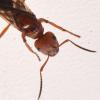I caught these ones at the same time as the Lasius alienus, but these ones are obviously different and are around the same length. Looks more like a myrmica or crematogaster than a formica/lasius queen.
Location: Surrey, BC, Canada (Tynehead Park) [coordinates - 49.177814, -122.744972]
Date of Collection: July 4, 2018
Habitat: Park / Forest near the parking lot
Length: 8mm
Coloration: mostly black with a brown hue around the legs, antenae, and mandibles.
Distinguishing characteristics: two petioles, spikes at the end of the thorax, fine hairs all over the body, 12 antennal segments
Nuptial flight must have been in the early afternoon to late afternoon. caught roaming around between 5-7pm.
Google Photo Album - https://photos.app.goo.gl/9tdMpfZUtuKvVSDs8



















